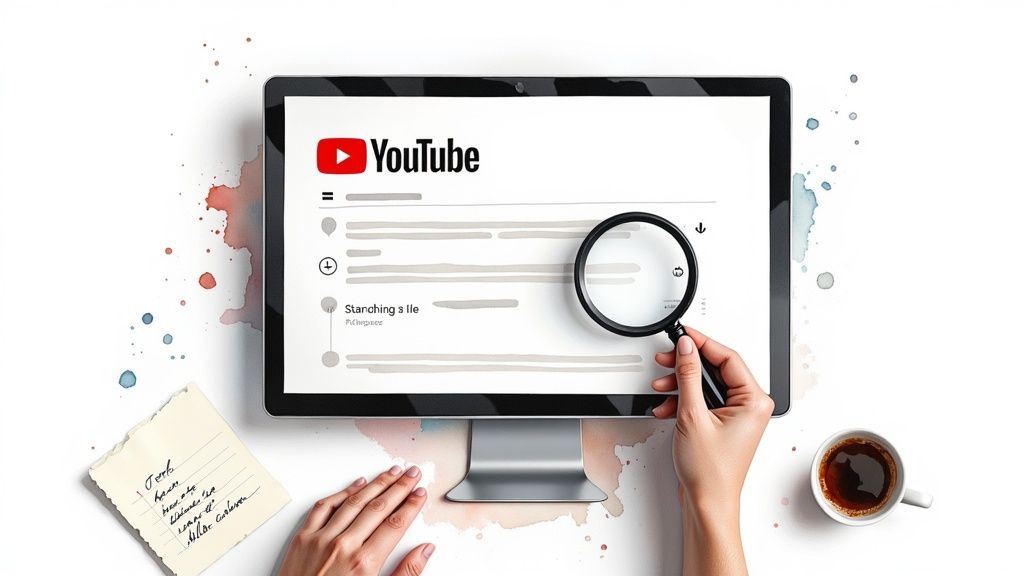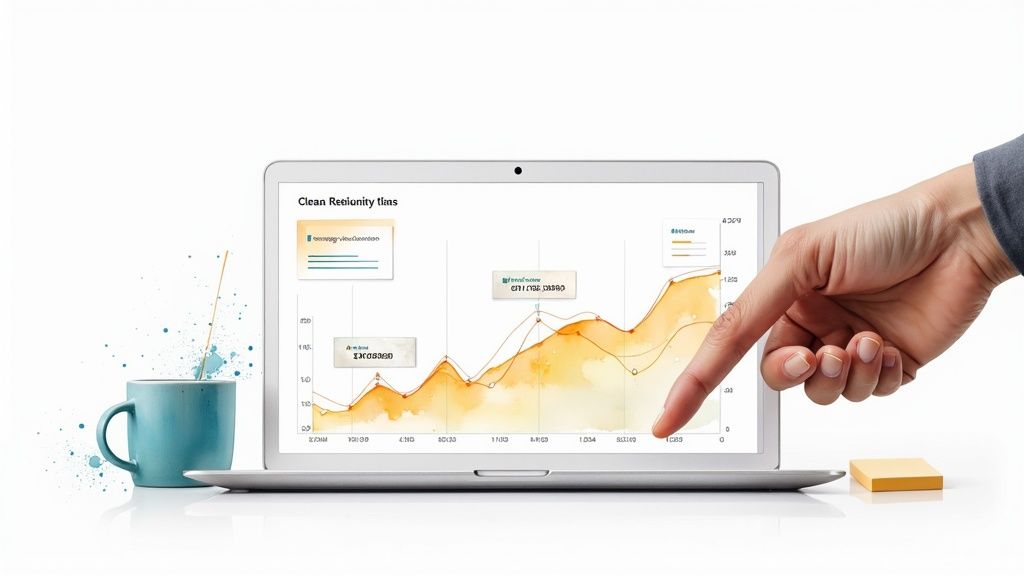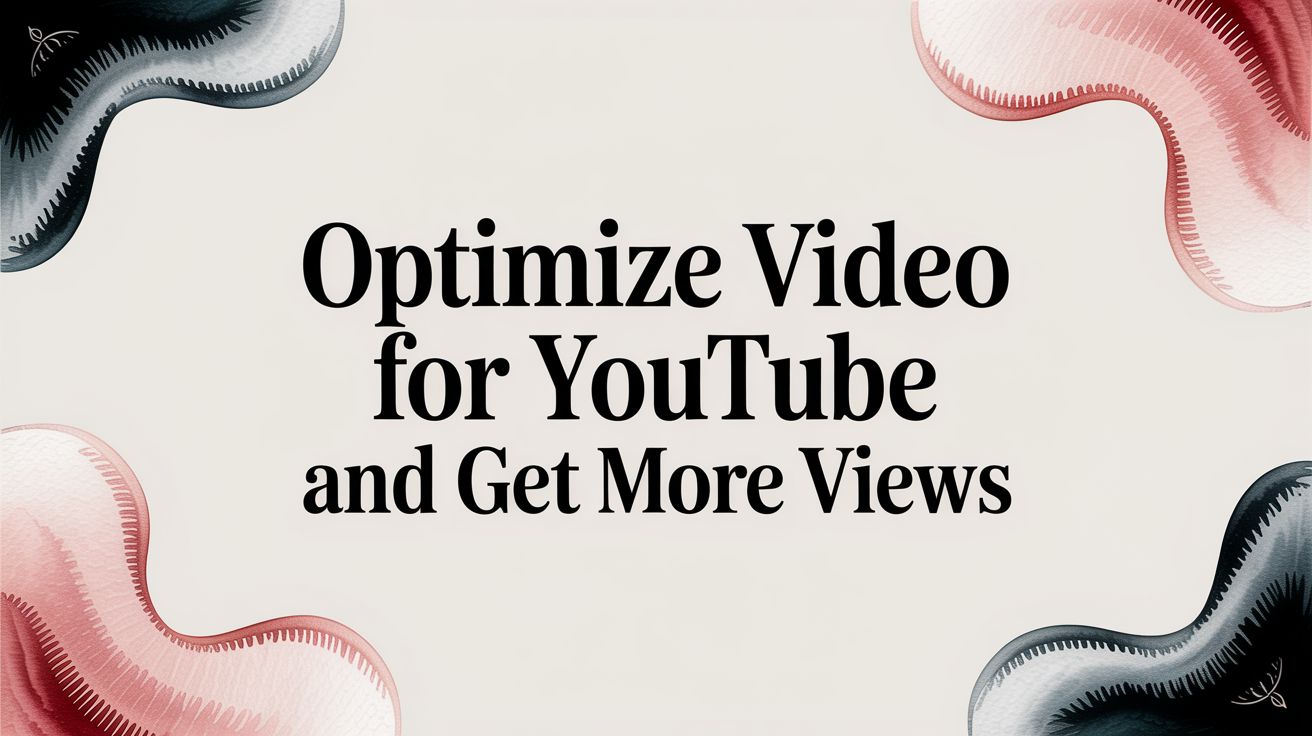Want your videos to succeed on YouTube? Your work starts long before you even think about hitting that upload button.
Getting the foundation right—from the technical specs of your video file to the core idea behind it—is the difference between a video that sinks and one that swims. Think of it as setting the stage. Without a solid stage, even the best performance will fall flat.
Building Your Pre-Upload Foundation

So many creators get this backward. They pour all their energy into titles and tags, thinking that’s where the magic happens. But the real work—the stuff that truly moves the needle—happens in the edit bay and during your initial brainstorming.
The raw quality of your video file speaks volumes to YouTube's algorithm. A poorly encoded video or a great idea aimed at no one, in particular, is dead on arrival. Let's walk through the critical decisions you need to make before uploading to give your content a fighting chance.
Nailing the Technical Specifications
First things first, let's talk tech. YouTube re-encodes every single video you upload. To make sure your content looks crisp and professional after their process, you have to feed it a high-quality file from the start.
Here are the non-negotiables for your export settings:
- File Format: Stick with MP4. It's the gold standard for a reason, offering the best mix of quality and file size. It's what YouTube prefers, so don't overthink it.
- Video Codec: Always use H.264. This is the industry-standard codec that ensures maximum compatibility and quality retention through YouTube's compression.
- Resolution: Export at the highest resolution your project allows. Aim for 1080p (1920x1080) at a minimum, but if you shot in 4K (3840x2160), export in 4K. A higher-quality source file means your video will look better, even when viewers watch it on a lower setting.
- Frame Rate: Keep it consistent. Match your export frame rate to whatever you recorded in, whether that’s 24, 25, 30, or 60 FPS. This simple step prevents weird motion stuttering.
Getting these settings right is your first handshake with the algorithm. You're signaling that you're a serious creator who cares about the viewing experience.
Encoding for Quality and Performance
Bitrate is another piece of the puzzle. It controls how much data is used for each second of video. Higher bitrate means better quality but a bigger file. For most of us, a variable bitrate (VBR) is the smartest option because it allocates more data to complex, fast-moving scenes and less to simple, static ones.
As a rule of thumb, a target bitrate of 8-12 Mbps is a solid starting point for a 1080p video at 30 FPS. If you're working with 4K, you'll want to bump that up to 35-45 Mbps. To dive deeper into this, you can learn more about how to choose the best bitrate for streaming in our detailed guide.
I can't tell you how many times I've seen a fantastic video concept completely torpedoed by bad export settings. It's the single biggest technical mistake new creators make. Poor encoding tells viewers and the algorithm that your content isn't worth their time.
Developing a Smart Content Strategy
Now, let's move beyond the technical weeds. What you actually decide to create is arguably the most important decision of all. It’s tempting to chase a viral trend, but that’s a short-term game. Building a channel that lasts requires a real strategy.
Before you ever hit record, you need to have clear answers to these questions:
- Who is this for? And be specific. "Gamers" is an ocean. "Busy parents who want to play cozy farming sims on the Nintendo Switch" is a specific audience you can actually connect with.
- What value am I providing? Is your video going to solve a problem, make someone laugh, or teach them a new skill? Every video needs a purpose.
- What's my unique spin? The topic might be common, but your personality, editing flair, or unique perspective is what will make people subscribe to you.
This strategic thinking ensures your videos aren't just random shots in the dark. You're building a library of content for a specific community, which is how you grow a loyal audience. This is the true heart of how you optimize video for YouTube.
Mastering YouTube SEO to Rank Higher

It’s easy to think of YouTube as just a place to watch videos, but that’s a huge mistake. YouTube is the world's second-biggest search engine, trailing only Google. The moment you start treating it like one, you’ll change how you create and publish content forever.
Getting your videos discovered is all about speaking the algorithm’s language. This isn’t about trying to game the system. It’s about giving YouTube clear, strong signals about what your video is about and who it’s for. Nail this, and the platform will reward you by putting your content in front of people who are actively searching for it.
Finding Keywords People Actually Search For
Great YouTube SEO starts with solid keyword research. You have to get inside the head of your ideal viewer and figure out the exact words and phrases they're typing into that search bar. Skipping this step is like setting sail without a map—you're just guessing.
One of the best (and easiest) ways to do this is by using YouTube's own search suggestions. Just start typing a broad topic into the search bar. The autocomplete suggestions that pop up are a goldmine because they’re based on what real people are searching for right now.
For instance, if you type "how to edit video," you’ll likely see suggestions like:
- how to edit video on iphone
- how to edit video for youtube
- how to edit video like a pro
These aren't random guesses; they're direct clues about what your audience wants to watch. Creating content around these terms gives you a built-in audience from the get-go.
Crafting Compelling Titles and Descriptions
Once you've picked your main keyword, your title is the first place you need to put it. A great title does two things at once: it hooks a human viewer with a compelling promise and it tells the algorithm exactly what to expect. It's a balance between searchability and pure curiosity.
Imagine you made a video about baking. A title like "Sourdough Bread" is way too generic to stand out. A much stronger title is "Easy Sourdough Bread Recipe for Complete Beginners." It targets a specific keyword and speaks directly to a specific audience.
Next up is your video description—a seriously underrated SEO tool. Don't just toss in a single sentence and call it a day. To really get noticed, aim for a description of at least 250 words and mention your primary keyword 2-4 times. With video projected to make up 82% of all internet traffic, getting this right is non-negotiable. You can dive deeper into the data by checking out the research on how to rank YouTube videos on Backlinko.
Your video description is your chance to provide rich context. Use it to summarize the video's value, add relevant links, and include timestamps for longer videos to help viewers navigate to key sections. This not only helps SEO but also improves the user experience.
To help you stay on track, I've put together a quick checklist. Use this for every video you upload to make sure you're hitting all the essential SEO marks.
YouTube SEO Elements Checklist
| SEO Element | Best Practice | Why It Matters |
|---|---|---|
| Video Title | Include the main keyword naturally. Keep it under 60 characters to avoid it being cut off in search results. | The title is the strongest signal to both viewers and the algorithm about your video's topic. |
| Video Description | Write at least 250 words. Place your primary keyword in the first 25 words. Mention it 2-4 times. | Provides detailed context, allows for secondary keywords, and can include links to drive traffic. |
| Tags | Use a mix of primary, secondary, and broad tags. List your most important keyword first. | Helps YouTube categorize your video and show it as a "suggested" video next to similar content. |
| Spoken Keywords | Say your target keyword in the video itself, ideally near the beginning. | YouTube's automatic transcription can pick up on spoken words, adding another layer of SEO context. |
| Hashtags | Include 3-5 relevant hashtags in the description to aid in discoverability. | Groups your video with other content using the same hashtag, making it easier for users to find. |
This checklist is your pre-flight routine. Going through it consistently ensures you're not leaving any easy views on the table.
A Strategic Approach to Tags
Tags are your way of giving YouTube extra clues about your video's subject matter. While they might not have the same direct ranking power they once did, they are still incredibly important for getting your video to appear in the "suggested videos" sidebar. That’s a huge source of views.
I like to think about tags in three layers:
- Primary Tag: Your main target keyword. This should always be your very first tag.
- Secondary Tags: Variations of your main keyword and other related phrases you discovered during research.
- Broad Tags: General, category-level terms that describe the overall topic.
Let's go back to our sourdough video. A good tag strategy would look like this:
- Primary: "easy sourdough bread recipe"
- Secondary: "sourdough for beginners," "how to make sourdough starter," "no-knead sourdough"
- Broad: "baking," "bread making," "home cooking"
This layered approach gives the algorithm a ton of data to work with, dramatically increasing the odds that your video gets recommended to the right person at the right time.
Creating Thumbnails That Earn the Click

After all the hard work you've put into your video and its SEO, there's one final gatekeeper standing between you and a new viewer: the thumbnail. Think of it as your video's billboard in a sea of competing content. It has just a split second to convince someone that your video is the one they need to watch.
A fantastic thumbnail paired with a killer title is an unstoppable force. But a weak one? It can make all your previous effort completely invisible. It's the visual handshake that starts the conversation, so it has to be strong and intriguing.
The Anatomy of an Irresistible Thumbnail
Designing a great thumbnail is less about artistry and more about the science of grabbing attention. The goal is to create something that’s instantly understood, sparks an emotional reaction, and pops off the screen—whether it's on a giant TV or a tiny phone.
Your thumbnail should tell a micro-story. What's the core promise of the video? What feeling will the viewer get? Your design choices have to answer those questions in the blink of an eye.
Here’s what I’ve found works every time:
- High-Contrast Colors: Use a vibrant, punchy color palette that stands out against YouTube’s interface (white, grey, or dark mode). Bright yellows, electric blues, and rich reds are your best friends here. Steer clear of muted, muddy colors that just blend in.
- Expressive Human Faces: We are biologically wired to notice and connect with faces. A clear shot of a person showing a strong, relatable emotion—like surprise, excitement, or deep concentration—is incredibly powerful for drawing the eye.
- Minimal, Bold Text: If you add text, keep it short and sweet. Think three to five powerful words, max. The font needs to be bold and super readable, even at a small size. This text shouldn't just repeat the title; it should add a new layer of intrigue. For example, if the title is "How to Bake Sourdough Bread," the thumbnail text could be "NO MORE MISTAKES!"
Crafting an Intro That Hooks Viewers Fast
Okay, you got the click! Now the clock is ticking. You have about 5 to 10 seconds to prove to the viewer that they made the right choice. A slow, boring, or confusing intro is the quickest way to send them packing.
The moment someone lands on your video, their brain is asking, "Is this what the thumbnail promised? Is this worth my time?" Your intro has to scream "YES!" to both.
Viewer behavior has always been at the heart of YouTube optimization. A compelling thumbnail is what gets your click-through rate (CTR) up, which is a massive signal to the algorithm. And with over 2.5 billion monthly active users, standing out is everything. If you want to dive deeper into this, you can explore this in-depth guide to the YouTube algorithm on Codolin.com.
To get your audience hooked from the very first second, try one of these proven strategies:
- State the Value Proposition: Right away, tell them what they’re going to get. "In the next five minutes, you'll learn the one trick that completely changed how I edit photos."
- Ask a Compelling Question: Pose a question that they're desperate to have answered. "Ever wonder why your houseplants keep dying, even when you follow the instructions to the letter?"
- Use a Quick-Cut Montage: Show a rapid-fire sequence of the most exciting or visually stunning moments from the video. This injects instant energy and promises an engaging ride.
A huge mistake I see all the time is starting videos with long, animated logo sequences. Honestly, viewers don't care about your logo; they care about the solution to their problem. Get straight to the point and deliver on the promise you made.
By mastering this one-two punch—a clickable thumbnail and a gripping intro—you create a powerful gateway to your content. This initial engagement sends a critical signal to the YouTube algorithm that your video delivers on its promises, making it more likely to be recommended to a wider audience. It’s the foundation for everything that follows.
Keeping Viewers Hooked is Half the Battle
Getting someone to click on your video is a huge win, but let's be real—that's just the start. The real magic happens when you convince that viewer to stick around for the whole thing. We're talking about audience retention, which is just the fancy term for the percentage of your video that people actually watch.
This is arguably one of the most powerful signals you can send to the YouTube algorithm.
A high retention rate is your way of telling YouTube, "Hey, people are genuinely into this!" In turn, the algorithm is far more likely to serve your video up in search results and pop it into the "suggested videos" sidebar. This is how you go from just getting views to building real, sustainable momentum.
Keeping Your Audience Glued to the Screen
Think about your video like a good story. If it's just one long, monotonous ramble, people are going to check out. The secret is to keep their brains from wandering by introducing small, interesting changes along the way.
This is where pattern interrupts become your best friend. These are tiny, deliberate events you sprinkle throughout your video to break the visual monotony and snap a viewer's attention back into focus.
- On-Screen Graphics: A quick pop-up with a key phrase or a simple graphic that illustrates what you're saying can instantly pull a viewer back in.
- Zoom and Angle Changes: You'd be surprised how effective a subtle zoom-in is when you're about to make a crucial point. It just feels more important.
- B-Roll Footage: Don't just show your face the whole time. Cutting away to relevant footage while your voiceover continues keeps the visual experience fresh and engaging.
These aren't just flashy editing tricks for the sake of it. They're strategic tools you can use to fight off viewer fatigue and keep eyeballs on your screen. The longer you can hold their attention, the more valuable the algorithm thinks your video is.
Using YouTube’s Own Tools to Your Advantage
YouTube actually gives you a powerful little toolkit to guide the viewer's journey and ramp up engagement. Two of the most important features here are Cards and End Screens. Learning to use them well is a fundamental part of optimizing your videos.
An End Screen is that overlay you see in the final 5-20 seconds of a video. This is your primetime opportunity to tell viewers what to do next. Instead of letting them drift away to a competitor's cat video, you can point them directly to another video of yours or give them a big, juicy "Subscribe" button.
Cards, on the other hand, are the small, clickable notifications that can pop up at specific moments during your video. You could use a card to link to a relevant playlist, another channel you're collaborating with, or a specific video that goes deeper on a point you just made.
My Pro Tip: Never, ever leave the viewer guessing what to do next. A simple, verbal call-to-action like, "If you want to go deeper on this, I've linked my full guide in a card right up here," can massively increase clicks and keep people binge-watching your content.
It's All About Community
Engagement isn't just a numbers game about watch time. It's also about the conversation happening around your video. Likes, shares, and especially comments are all super strong signals to YouTube that your content is actually making an impact on people.
So please, don't just upload and ghost. Make it a habit to hang out in the comments section, especially within the first few hours after you publish. When you reply to comments, two amazing things happen:
- You make your audience feel heard and valued, which is how you build an incredibly loyal following.
- You literally double the number of comments on your video, which juices up those engagement signals even more.
Pinning a thoughtful comment or even asking a question in your own comment can get the ball rolling. This simple effort transforms passive viewers into a real community—and the algorithm absolutely loves to see that.
And if you're looking for ways to keep your audience engaged between your main uploads, you might want to check out some of these evergreen streaming ideas that are perfect for maintaining viewer interest.
Let's quickly break down how some of these tactics stack up against each other.
Engagement Tactics Comparison
I've found that different tactics serve different purposes. Some are great for keeping people watching, while others are better for building that long-term community feel. Here's a simple comparison of my go-to strategies.
| Tactic | Primary Goal | Implementation Example |
|---|---|---|
| Pattern Interrupts | Boost Audience Retention | Using a quick zoom or an on-screen graphic to highlight a key point and reset viewer attention. |
| End Screens | Increase Session Watch Time | Suggesting a related video from your own channel in the final 20 seconds to keep viewers from leaving. |
| Replying to Comments | Build Community & Signals | Taking the time to answer viewer questions, which sparks more conversation and fosters a loyal tribe. |
| In-Video Calls-to-Action | Drive Specific Actions | Directly asking viewers to "like the video if you got any value from it" right after a big "aha" moment. |
At the end of the day, this all comes down to respecting your viewer's time and attention. When you structure your video to be dynamic, use YouTube's tools the way they were intended, and actively build a real community, you're sending all the right signals that your content is worth watching—and promoting.
Let Data Be Your Guide

The difference between a successful creator and one who struggles often comes down to one thing: data. The pros don't just guess what their audience wants; they treat their channel like a lab, constantly testing and learning from the hard numbers.
Your YouTube Analytics dashboard is the key to all of this. It can feel like a lot to take in at first, but you don't need to track every single metric. You just need to know which ones tell the real story of what’s working and what’s falling flat. This is how you stop making content you think people want and start making content you know they do.
What Your Audience Retention Graph Is Telling You
If you only look at one piece of data, make it your audience retention graph. This simple line chart is a second-by-second report card on your video's performance, showing the exact percentage of viewers who are still watching at any given moment.
It’s a goldmine for honest feedback. Look for two specific patterns:
- Sudden Dips: A sharp drop in the graph is a red flag. It means something at that exact moment—a boring intro, a clunky transition, maybe a sponsor segment that went on too long—caused a chunk of your audience to leave. Pinpoint these spots to avoid repeating the mistake.
- Spikes and Bumps: See a little upward bump in the graph? That’s pure gold. It means people are rewinding to watch a specific part again. Whatever you did there was interesting, valuable, or entertaining. Figure out what it was and do more of it.
Your retention graph is the most direct, unfiltered critique you'll ever get. Learning to read its story is like gaining a superpower. It shows you precisely where you’re boring, where you’re brilliant, and where you need to improve.
The Two Numbers That Actually Matter
Your channel's success really boils down to two key metrics that the YouTube algorithm cares about most: Click-Through Rate (CTR) and Average View Duration (AVD). They work as a team.
- Click-Through Rate (CTR): This is the percentage of people who saw your thumbnail and title on their screen (an "impression") and chose to click. A high CTR proves your packaging is compelling.
- Average View Duration (AVD): This is how long, on average, people stick around once they've clicked. A high AVD proves your content delivered on the promise made by your title and thumbnail.
You need both. A high CTR with a low AVD is a classic case of clickbait—you tricked people into clicking, but they left immediately because the video wasn't what they expected. The magic happens when you have a high CTR and a high AVD. That’s the signal to YouTube that you've got a winner on your hands.
Follow the Traffic
Knowing how people find your videos is just as crucial as knowing if they enjoyed them. The "Traffic Sources" report in your analytics breaks this down for you. Are people finding you from YouTube Search? Suggested Videos? An external blog?
This information helps you double down on what’s working. If 80% of your views are coming from "Suggested Videos," it means you’re doing a great job of creating content that keeps people on the platform, and the algorithm is rewarding you for it. If "YouTube Search" is your biggest driver, you know your keyword strategy is paying off.
This data-driven mindset is essential in a creator economy that's bigger than ever. YouTube's ad revenue hit $8.92 billion in a single quarter, and with the platform projected to reach 2.85 billion users, the opportunity is massive. You can find more stats on YouTube’s growth and what it means for creators at GlobalMediaInsight.com.
By creating a feedback loop—reviewing retention, CTR, AVD, and traffic sources for every video—you turn guesswork into a reliable system for growth.
Common Questions About YouTube Optimization
Even with a solid game plan, you're bound to run into some head-scratchers. Let's walk through a few of the most common questions I hear from creators trying to get their channels dialed in.
How Long Should My YouTube Videos Be?
Honestly, there’s no magic number here. The right length is whatever it takes to get your point across effectively without boring your audience. A quick-tip video might be perfect at three minutes, while a deep-dive analysis could easily run for thirty.
Forget about hitting a specific time. Your real goal is to maximize Average View Duration. Focus on delivering value from start to finish. Cut the fluff. If you can cover your topic in seven minutes, don't stretch it to ten just to hit an arbitrary number. That's how you get viewers to click away.
How Often Should I Post New Videos?
This one's simple: consistency trumps frequency.
Putting out one fantastic video every single week is way better than dropping three rushed, mediocre ones. The YouTube algorithm loves a predictable schedule because it helps your audience build a habit of watching your content.
Find a rhythm that works for you. Look at your analytics, be realistic about your production time, and choose a schedule you can actually stick to. Whether it's weekly, bi-weekly, or even monthly, just be consistent. Burning out trying to post daily helps no one.
The biggest mistake I see is creators sacrificing quality for quantity. People subscribe because you bring them value, not because you upload constantly. A steady stream of great content always wins in the long run.
Does Video Quality Really Matter That Much?
Yes. One hundred percent, yes. In an ocean of content, solid production quality makes you stand out. You don't need a massive film crew, but your video and audio need to be clean and clear.
Think about it—viewers have zero patience for a video that's blurry, poorly lit, or has scratchy audio.
- Resolution: 1080p is the baseline. It just looks professional and is what people expect.
- Audio: This is non-negotiable. Bad audio is often more distracting than bad video. A good, affordable microphone is one of the best investments you can make.
- Lighting: You'd be amazed what good lighting can do, even for a smartphone camera.
High-quality production tells viewers you're serious about your channel. That builds trust and makes them more likely to stick around.
Should I Use Playlists on My Channel?
Playlists are your secret weapon for channel growth. They are incredibly powerful but so many creators completely ignore them. By grouping related videos, you create a binge-watching experience that keeps people on your channel.
Here's why they work so well: when one video in a playlist ends, the next one automatically begins. This directly pumps up your channel's session watch time, which is a huge signal to the YouTube algorithm to recommend your content more often.
Organize your videos into logical series or topics. Guide your viewers from one video to the next. If you have a lot of ongoing content, exploring what 24/7 live streaming is can be a game-changer for building up massive amounts of watch time.
Ready to put your channel on autopilot and accelerate your watch time? 24/7 LiveStream lets you turn your pre-recorded videos into a permanent, always-on live stream, keeping your channel active and visible around the clock. Start your 24/7 stream today and watch your channel grow.
